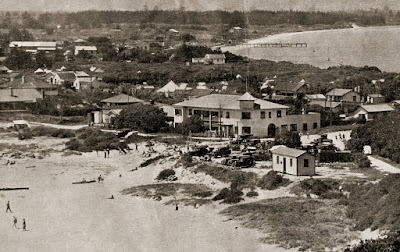 |
| Parlour display, in the former Katikati Heritage Museum |
One of the many esoteric and quirky groups of objects held by the Western Bay Museum (formerly the Katikati Heritage Museum) is a large stack of almost two hundred bricks. Why bricks, you may well ask. Well it seems that folk will selectively hoard, occasionally even seek out, pretty much anything old, whether it has an intrinsic value or not, and you don't have to go too far out of your way before you have a collection. Some were on display upstairs in the old museum's "Parlour" section, where they were used to provide a base and backdrop to a small cast iron stove and a miscellany of other household items. The provenance of the bricks is unknown, but the collection is likely to have been amassed from many different locations.
 |
| N.Z. Brick, Tile & Pottery Co. |
A few of the bricks are plain, revealing few clues as to their origin. Most have some remnants of a maker's mark on them, usually stamped onto the face of the brick during manufacture with the aid of a bespoke plate bolted into the brickmaking machine. This is usually referred to as a frog design, the "frog" being the indentation on the face used to better key in the mortar binding the bricks together.
The New Zealand Brick, Tile & Pottery Company (manager, Albert Crum) operated from works in New Lynn between 1905 and 1929.
 |
| New Zealand Brick, Tile and Pottery Company Ltd. trademark, 1909 |
There was another company with the same name in Canterbury between 1886 and 1890, but this brick is unlikely to have emanated from a firm which appears to have specialised in terra cotta and fire clay products.
 |
| Russell & Bignell, Wanganui |
Little is known about the firm of Russell and Bignell of "Wanganui," except that Arthur and Robert Russell built Wanganui Hospital and the
Pukemarama Homestead, the latter now cared for by Heritage New Zealand.
 |
| Sankey Aluma |
Some of the more specialised bricks were imported, presumably because products of the right quality were unavailable locally. This Sankey Aluma firebrick probably originated from the brickworks of J H Sankey & Son, Essex Wharf, Canning Town, London, a manufacturer of cement, lime and fire bricks from 1857 until the 1920s.
 |
| Koru and Tiki brick design, unidentified manufacturer |
In keeping with the flag debate currently sweeping New Zealand, this somewhat battered red clay brick has a rather nice koru and tiki design, but sadly no indication of the firm that made it. Perhaps a brick afficionado will be able to identify its manufacturer and place of origin?
 |
| Buller's Ltd. GPO telephone insulators |
I thought I'd include an item which isn't a brick at all, but ceramic insulators were often manufactured by the same companies that made bricks, and seem to attract just as many collectors/enthusiasts. These telephone insulators were manufactured by the English company, Buller's Ltd. and imported into New Zealand in great numbers from the early 1900s onwards, due to their exceptional quality. Much of the text of a recently published book,
Collecting Insulators in New Zealand: A Guide for Beginners, is available online for those readers who might wish to start their own collections. Sadly, I couldn't find a similar volume for would-be New Zealand brick hoarders.
Text and images by Brett Payne (who quietly confesses to having a
small brick collection of his own - only one brick, mind you.)
ReferencesBrickmakers in South Canterbury, New Zealand, by South Canterbury GenWeb, n.d.
http://www.rootsweb.ancestry.com/~nzlscant/brickmakers.htmBricks with names on Huntly, by KiwiAlan, 20 May 2011
http://www.huntly.net.nz/Bricks.htmlAlbert Crum’s New Zealand Brick, Tile & Pottery Company in New Lynn (1905-1929), on Timespanner blog, 19 January 2011
http://timespanner.blogspot.co.nz/2011/01/albert-crums-new-zealand-brick-tile.htmlTasker, J., Wilson, R. & Clark, G. (2015) Collecting Insulators in New Zealand: A Guide for Beginners, Kanuka Press.
https://books.google.co.nz/books?id=rzxyCQAAQBAJScotland's Brick Industry - Sankey Aluma
http://www.scottishbrickhistory.co.uk/sankey-aluma/Pukemarama, by Heritage New Zealand
http://www.heritage.org.nz/the-list/details/1191




















































